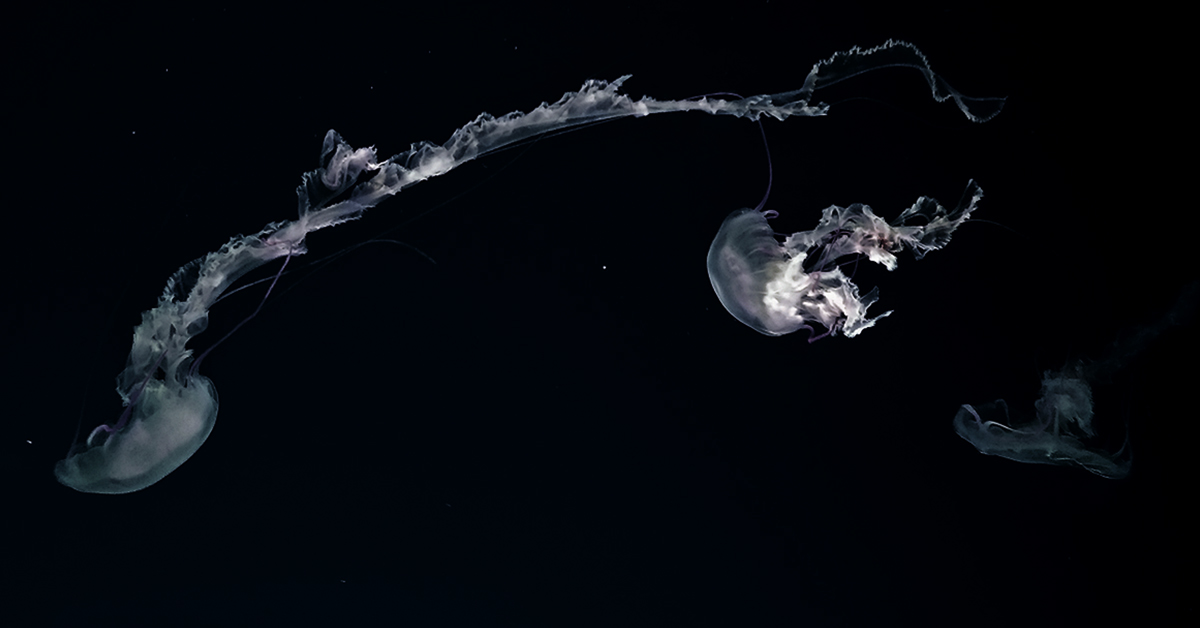Jellyfish are some of the ocean’s most mysterious creatures. They become even more elusive the deeper you go. Recently, researchers from the Monterey Bay Aquarium Research Institute (MBARI) captured footage of a giant phantom jellyfish – one of the rarest species of them all. Check out these videos.
Rare Footage Of A Giant Phantom Jellyfish
The phantom jellyfish is a very rarely spotted species. With over thousands of dives, these researchers have seen it only nine times. Since its first appearance in 1989, scientists have only seen this animal about 100 times in total. To say the phantom jellyfish is elusive would be an understatement. (1)
Read: Beachgoer Discovers Monstrous-Looking Deep-Sea Fish Rarely Seen Ashore
Though with this information it may seem like the phantom jellyfish gets its name from the fact that it is rarely seen, this isn’t true. It gets its name from its ghost-like appearance. It is a dark grayish color with a faint red light glowing eerily from inside its bell-shaped head. From there it’s got long, ribbon-like tentacles that can be more than 33 feet in length. Floating slowly and gracefully through the water, it looks otherworldly – like it really could be from the underworld or beyond the grave.
The primary reason why scientists so rarely see this jellyfish is because of the deep-sea environment in which it lives. Typically, you will find them 1000 to 4000 feet below the surface, where the pressure is intense, there is very little oxygen, and hardly any light. What may come as a surprise, however, is how widespread these creatures are. Researchers have spotted them in every single ocean except for the Arctic. (2)
The Giant Phantom Jellyfish
The Phantom Jellyfish is one of the largest jellyfish on Earth. Its head is more than one meter wide and its arms are more than 10 meters in length. Beyond its size range and where it lives, scientists don’t actually know much more about this species.
They think that it uses its long arms to trap unfortunate prey and pull it into its mouth. Researchers also think that it likely feeds on small fish and plankton. These, however, are all just theories. It moves using occasional pulses from its head to propel itself through the water.
The reason why the phantom jellyfish, among other species of their kind, are found in these parts of the oceans is because of their structure. The pressure at these depths is immense. Most other animals would be crushed quite quickly. Jellyfish, including the phantom, are as they are stated: Jelly. This allows them to work with the pressure rather than be squashed by it. In general, scientists have learned recently that jellyfish are some of the most important predators in the deep sea. Beyond these facts, there is still much to be discovered about these brainless creatures.
Read: World’s Largest Sea Turtle Emerged From The Sea And It Was Amazing
Documenting The Phantom Jellyfish
Since their location makes them hard to spot and harder to study. Jellyfish are also difficult to observe and research because traditional methods for capturing them don’t work. After all, it’s difficult to grab onto something that isn’t quite solid and haul it up from thousands of feet below the surface of the ocean.
“Historically, scientists relied on trawl nets to study deep-sea animals. These nets can be effective for studying hardy animals such as fishes, crustaceans, and squids, but jellies turn to gelatinous goo in trawl nets,” said scientists from MBARI.
Thankfully, over the years scientists have developed special submarine devices that can explore depths where humans can’t necessarily go to. On top of that, more recent 4k high-definition camera technology has provided us with an avenue to observe these sea creatures in their natural environments.
“The cameras on MBARI’s ROVs have allowed MBARI researchers to study these animals intact in their natural environment. High-definition—and now 4K—video of the giant phantom jelly captures stunning details about the animal’s appearance and behaviors that scientists would not have been able to see with a trawl-caught specimen.”
The researchers did note that there were certain species of deep-sea fish that would use the giant jellyfish as a refuge. They would sort of swim around the arms and bell of the animal. The scientists say this is likely because the deep open water offers very little protection for these small creatures. The jellyfish is one of the few options that they have to take shelter in.
While there is still much more to be learned about these amazing animals, this is certainly a very cool, unique look into their behavior and habits. For more information on this incredible animal, check out MBARI’s page dedicated to the awe-inspiring phantom jellyfish.
Keep Reading: Influencer Picks Up And Licks ‘Jellyfish’, Not Realizing It’s A Deadly Portuguese Man o’ War
Sources
- “Giant phantom jelly.” Mbari
- “Giant ‘phantom jellyfish’ that eats with mouth-arms spotted off California coast.” Live Science. Ben Turner. December. 2021.

